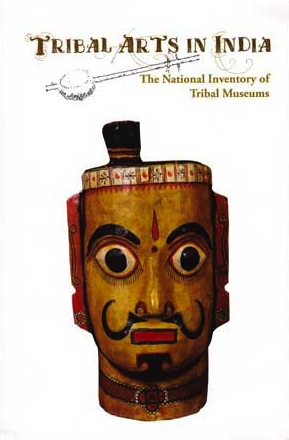Tips for using interactive maps
Toggle to normal view (from reader view) should the interactive map not be displayed by your tablet, smartphone or pc browser
For details and hyperlinks click on the rectangular button (left on the map’s header)
Scroll and click on one of the markers for information of special interest
Explore India’s tribal cultural heritage with the help of another interactive map >>
Tip: Click the button on the left top to select the layer labelled Ethnographic Museums; then scroll to find the Ethnographic museum in a region of special interest, and click on its rhombus-shaped (purple) placeholder for more information (including a link to its official website)

Tribal Arts in India | Worldcat.org >>
Free eBooks & Magazine by Bhasha Research and Publication Centre: Adivasi literature and languages >>
Museums have through the years been seen as institutions involved in the research, conservation and dissemination of information. India has eighteen Tribal Research and Training Institutes which run fourteen Ethnographic Museums with a combined collection of nearly 30,000 artefacts such as paintings, ornaments, costumes, hunting and agricultural implements, pottery, toys and religious objects; with each museum having collected artefacts from its own area of activity. Viewed collectively, these artefacts present a unique picture of the diversity and cultural richness of Tribal India.
The National Consortium of Tribal Arts and Culture (NCTAC) project was undertaken by Bhasha Research and Publication Centre with the support of the Ministry of Tribal Affairs, Government of India. Spanning a period of two years from January 2007, the project created a digital repository of tribal arts and culture as documented by these ethnographic museums since Independence.
The main goal of the project has been to connect the audiences with the tribal contexts through the use of digital technology and multimedia. This was done through the installation of dynamic digital displays in the participating museums. These displays are created with a view to bring together films, photographs, songs and stories reflecting the richness of tribal life and the contexts of use of over 700 tribal artefacts featuring in this dynamic collection. It is hoped that this book along with these displays will serve as a window to the lives of different tribal communities of the country and will help establish a fruitful dialogue between the numerous and divergent traditions of art and culture. The National Consortium of Tribal Arts and Culture (NCTAC) was conceived with the following objectives: 1) To form a network for interaction between the Tribal Research Institutes and various independent researchers in the country and abroad; 2) To encourage tribal art and culture through the support and participation of the people of India. […]
Source: Tribal Arts in India: The National Inventory of Tribal Museums (2012) | Learn more and ordering details >>
[Bold typeface added above for emphasis]
Ethnographic Museums (14) run by India’s 18 Tribal Research and Training Institutes
Find a Tribal Research Institute (TRI) in India >>
(up-to-date list on the TRI Portal of the Ministry of Tribal Affairs, Government of India)
State, Capital & Ethnographic museum
India’s ethnographic museums
Andhra Pradesh (Hyderabad) – Govt. of India | Please use the custom search field below for up-to-date information
Related posts about this state/region: www.indiantribalheritage.org >>
Assam (Dispur) – Govt. of India | Please use the custom search field below for up-to-date information
Related posts about this state/region: www.indiantribalheritage.org >>
Gujarat (Gandhinagar) – Govt. of India | Please use the custom search field below for up-to-date information
Related posts about this state/region: www.indiantribalheritage.org >>
Jharkhand (Ranchi) – Govt. of India | Please use the custom search field below for up-to-date information
Related posts about this state/region: www.indiantribalheritage.org >>
Kerala (Thiruvananthapuram) – Govt. of India | Kerala Institute for Research, Training & Development Studies of SC/ST (KIRTADS, Kozhikode) | Please use the custom search field below for up-to-date information Related posts about this state/region: www.indiantribalheritage.org >>
Madhya Pradesh (Bhopal) – Govt. of India | Please use the custom search field below for up-to-date information
Related posts about this state/region: www.indiantribalheritage.org
Maharashtra (Mumbai) – Govt. of India | Please use the custom search field below for up-to-date information
Related posts about this state/region: www.indiantribalheritage.org >>
Manipur (Imphal) – Govt. of India | Please use the custom search field below for up-to-date information
Related posts about this state/region: www.indiantribalheritage.org >>
Orissa / Odisha (Bhubaneshwar) – Govt. of India | Museum of Tribal Arts and Artifacts, SC/ST Research and Training Institute (Bhubaneshwar) | Please use the custom search field below for up-to-date information
Related posts about this state/region: www.indiantribalheritage.org >>
Rajasthan (Jaipur) – Govt. of India | Please use the custom search field below for up-to-date information
Related posts about this state/region: www.indiantribalheritage.org >>
Tamil Nadu (Chennai) – Govt. of India | Please use the custom search field below for up-to-date information
Related posts about this state/region: www.indiantribalheritage.org >>
Tripura (Agartala) – Govt. of India | Please use the custom search field below for up-to-date information
Related posts about this state/region: www.indiantribalheritage.org >>
Uttar Pradesh (Lucknow) – Govt. of India | Please use the custom search field below for up-to-date information
Related posts about this state/region: www.indiantribalheritage.org >>
West Bengal (Kolkata) – Govt. of India | Please use the custom search field below for up-to-date information
Related posts about this state/region: www.indiantribalheritage.org >>
Indian tribal cultural heritage: museum collections, eBooks, maps & more
Anthropological Survey | Anthropology
Books on tribal culture and related resources
Crafts and visual arts | Homes and utensils Crafts and visual arts | Masks
Cultural heritage | Revival of traditions
Dress and ornaments | Fashion | Tattoo
eBook | Background guide for education
eBook | Free catalogue: Banam: One of the ancient musical instruments of the Santals – West Bengal
eBook | Free catalogue: Museum of Santal Culture (Bishnubati) – West Bengal
Games and leisure time | Martial arts
India’s 28 States and 8 Union Territories – From Andhra Pradesh to West Bengal
Tribal customs, homes and ornaments in South India: Videos and photographs by Vicky Lakshmanan